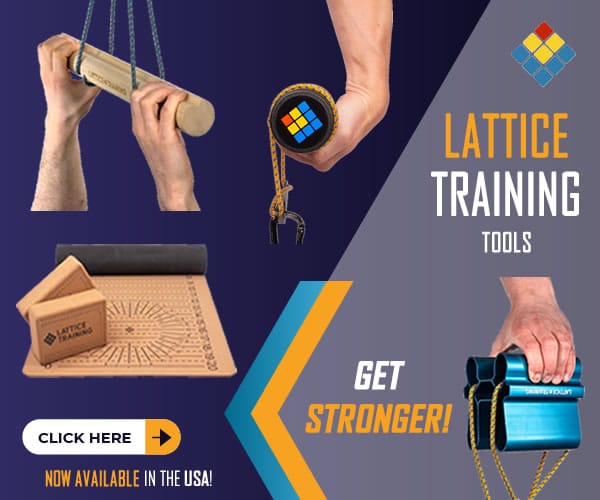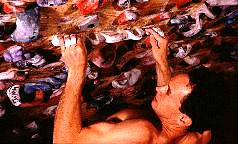
Eric Hörst testing prototype H.I.T. Strips circa 1996.
Q: How much weight do you use for your HIT Workouts?
A: I developed the HIT Workout over several years in the early- to mid-1990s, and I’ve since incorporated HIT as part of my year-round training for climbing. Initially, I trained with weights in the 5 to 15 pound range, but I found that the incredible effectiveness of this routine had me doubling the weights in a matter of months. With the 4th generation HIT Strips, I’m using about 60 lbs for my strongest grip positions (crimp, and 1st- and 2nd-team two finger) and about 30 pound for the 3rd-team two finger and pinch. (I don’t train open hand grip on the HIT Strips, because it would require a ridiculous amount of weight.) At 160 lbs body weight, that has me training my most important grips at a body weight of 220lbs. Now that’s hypergravity! After a while, climbing at regular body weight starts to feel strangely “light”, kind of like walking after you’ve taken off a heavy backpack or ski boots. Ever feel that effect?
I must stress that it took me over three years to gradually increase my weights up to that level. Also, I’ve been climbing for many years, so my tendons have had decades to slowly increase their strength. If you’re going to do HIT Workouts, you need to be mature and follow the protocol precisely! That means, limiting HIT Workouts and frequency, getting proper rest and nutrition, engaging in a slow warm-up, and committing to protective taping (when training with weight).
Q: I’ve been using your HIT Workout, and the results are impressive! Upon completing a HIT Workout, however, it seems that while my forearms are blown, the muscles in my upper arms and back are not. Can I do any other training exercises on my HIT Workout day?
A: While further finger training will be of little or no benefit, I do encourage you to do a few pull-muscle exercises to complete your workout. I suggest a few sets of one-arm lock-offs, weighted pull-ups, or uneven grip pull-ups.
Q: A Climbing magazine review of “System Training” mentioned that you can not train underclings on your HIT Strips. Is there a supplemental undercling exercise I should be doing in addition to my HIT Workout?
A: In the article you mentioned, the Climbing mag “reviewer” was mistaken in his understanding of the fundamentals of training for climbing. Before I answer your question, let me straighten out two misconceptions that may exist.
• Misconception #1: HIT Workouts are the same as System Training.
Not true. Although the wall set-up may seem similar, the training protocol is much different. HIT is unique in many ways, but the two most fundamental differences are the progressive adding of weight to your body over the training period AND the pin-point isolation of five key grip positions that are worked to failure! The HIT Strips offer the idea platform for HIT Workouts as they enable you to repeatedly grab holds of the exact same size and configuration. Isolating exact grip positions and climbing to failure on that single position is the skeleton key to unlocking higher levels of finger strength.
•Misconception #2: Underclings are a grip position.
Actually, underclings are an arm position that can be performed with any of the key grip positions trained with the HIT Workout. Thus, to say that HIT Workouts don’t train underclings is to miss the point that the sole focus of HIT Workouts is to train maximum grip strength. Max strength training of the larger muscles of the arms, shoulders and back should be done separate from maximum strength training of the fingers. Again, isolation and specificity are key.
Now back to your original question. The best way to train the muscles used in the undercling arm position is to do a traverse or boulder problem that includes several underclings back-to-back. Using an indoor wall is best as you can do 10- to 20-move traverses exclusively with underclings. Do a few sets, underclinging with your arm at different elbow angles. For example, do a set (10 to 20-move lap) with low underclings near your thigh, then a set with waist-high underclings and finish with a set of high underclings near your face.
Q: Can I do HIT Workouts using modular holds instead of your HIT Strips?
A: Yes, if you have 10 identical two finger pocket holds, 10 identical crimp holds, and 8 identical pinch holds that are all “usable” on a 50-degree overhanging wall. Of course, if you don’t have these holds it may cost you as much or more than the Nicros’ HIT System. Even more important, using HIT Strips keeps you focused on the goal of only using the specific grip being trained—there’s no cheating—whereas using modular holds opens the door to breaking the sequence and grabbing larger modular holds as you fatigue. Finally, the HIT Strips are optimized for use of the proper angle wall and possess a relatively comfortable ergonomic radius of curvature ideal for climbing with added weight.

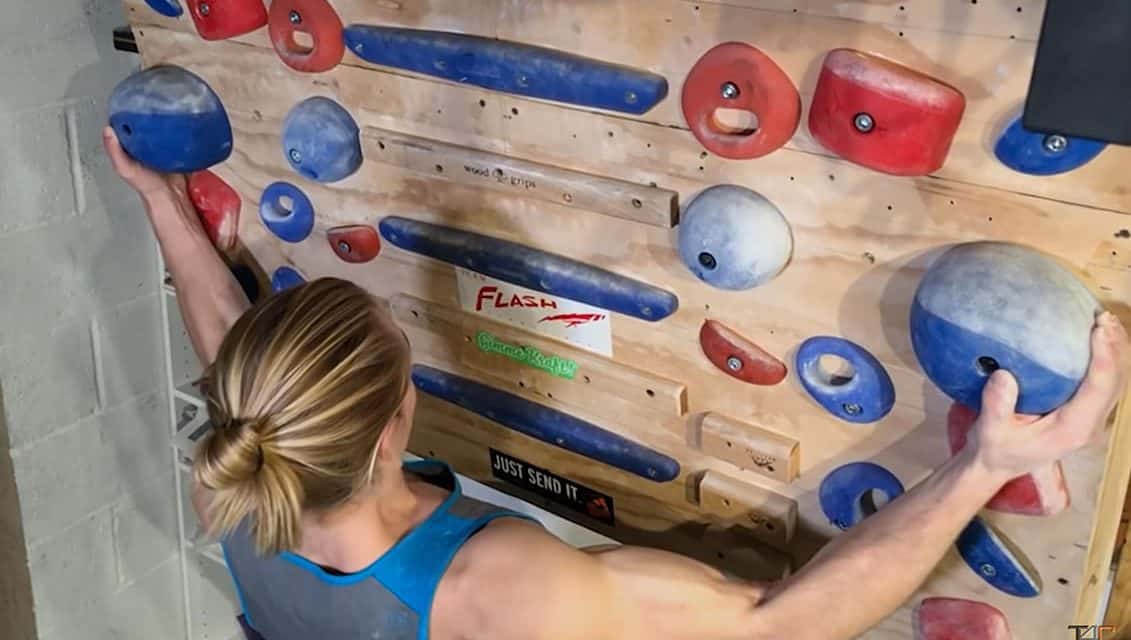
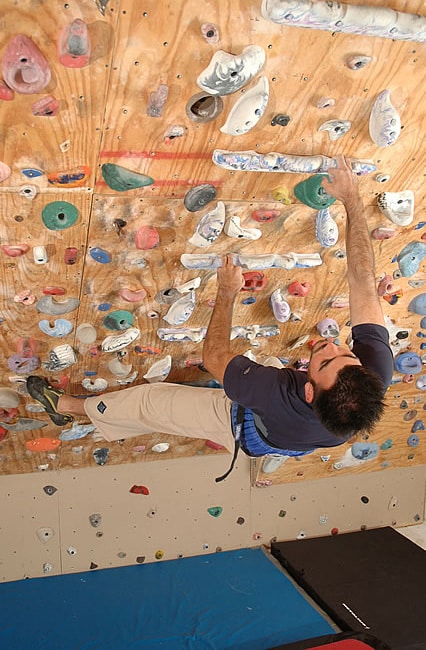


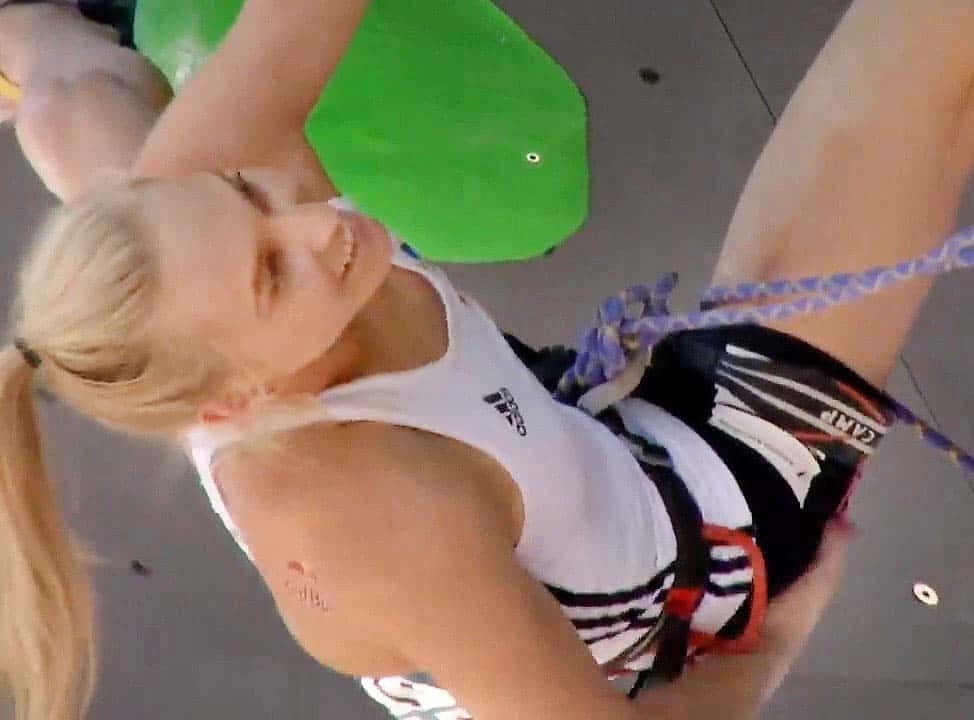

![🚨New Training For Climbing podcast drop! [**Link in bio.**]
This a two-part deep dive into designing a comprehensive, long-term systems approach to training. Coach @eric_horst unpacks—in rich detail—how systems actually function, and he highlights how transformative climbers throughout history “shake up the box” with innovative, highly effective methods to achieve big goals and push the boundaries of our sport.
In Part 1 (#122), Eric blends a concise climbing history lesson with an engineer-like breakdown of how intelligent systems operate. Part 2 (#123) of this series will deliver the actionable strategies you can use to build a personalized, high-performance training system for this winter…and for many seasons to come.
Eric emphasizes that as climbers progress beyond the beginner stage, climbing and training grow increasingly complex—requiring intentional, organized, and year-round development of strength, technique, mental skills, recovery habits, nutrition, and lifestyle management. Rather than ad-lib sessions or singular-focus programs (like only training strength), climbers need a comprehensive system fine-tuned daily and seasonally.
This is an entertaining and thought-provoking episode—so lean in, listen closely, and get ready to feel inspired, challenged, and equipped to level-up your modus operandi at the crag, in the gym, at home, and in everything you do! Listen on Apple Podcasts, Spotify, or online using the web player below.
#climbingtraining #bouldering #indoorclimbing #climbing #climbingpodcast #erichorst #trainingforclimbing @lasportivana @physivantage](https://trainingforclimbing.com/wp-content/plugins/instagram-feed/img/placeholder.png)

